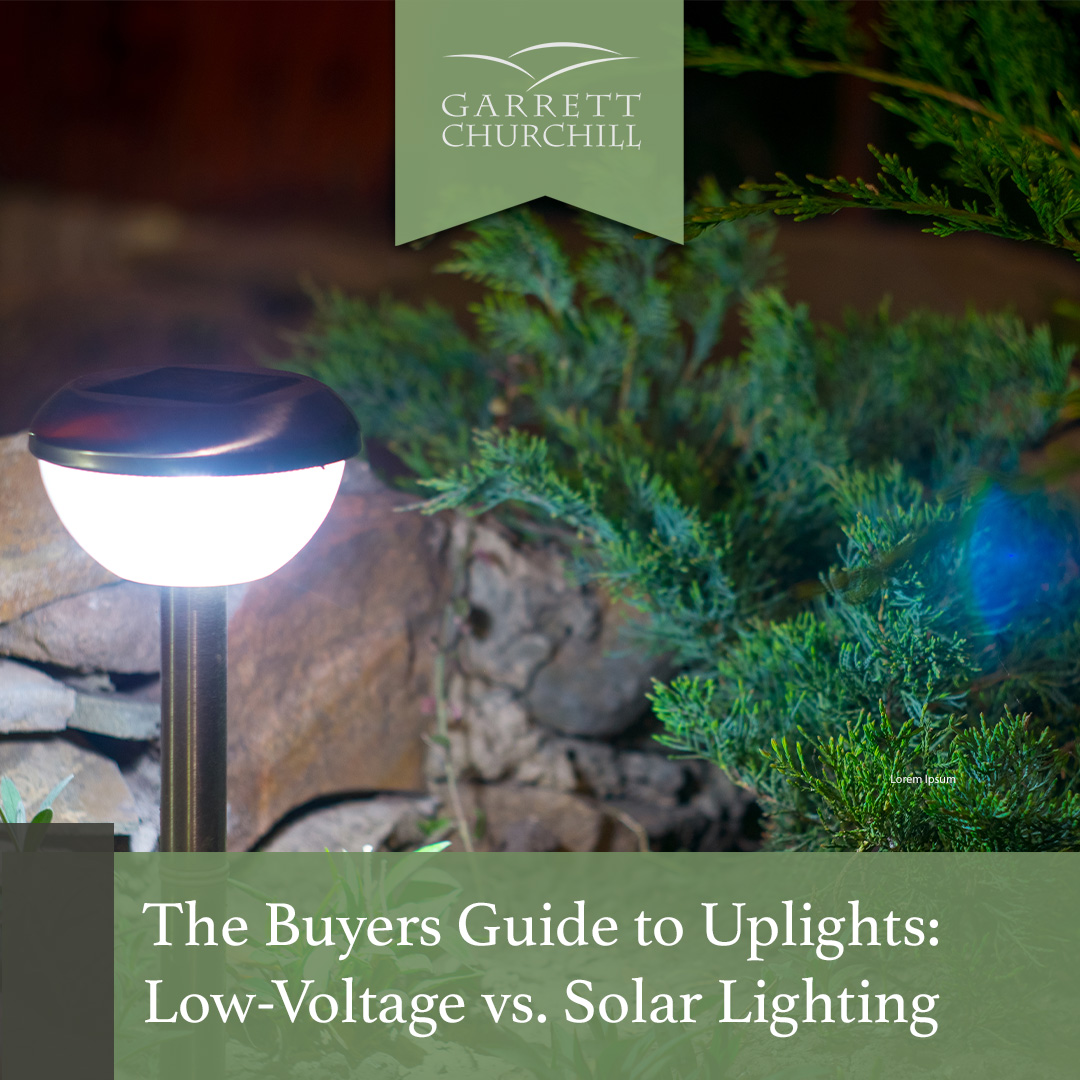The Buyer’s Guide to Uplights: Low-Voltage vs. Solar Lighting
An investment in outdoor lighting gives you the opportunity to fully appreciate the beauty of your landscape design. Proper outdoor lighting can maximize the appearance and security of your home, and uplighting can show off the intricate pattern of your tree limbs or the colorful foliage of your garden.
If you are interested in adding landscape lighting to your yard, there are a few things to consider, from practicality to aesthetic appeal. Keep reading to understand the pros and cons of solar vs. low-voltage lighting.
What are Uplights?
Uplighting refers to the directional focus of the light. Landscape uplights are usually placed at ground level and shine light upward to illuminate garden features such as branches, a prized plant, the façade of your home, or an ornate architectural feature.
What is Low-Voltage Landscape Lighting?
Low-voltage landscape systems use transformers to reduce standard home electrical current to 12-18 volts, providing energy efficient power. They rely on underground low-voltage cable lines to illuminate LED lamps.
LED lamps come in various styles and finishes with dramatic effects. The lamps are incredibly long-lasting, with a life expectancy longer than 10,000 hours.
Low-voltage LEDs are a low-cost lighting option compared to the investment of a professional electrician installing line or house voltage (110 volt) landscape lights.
Advantages of Low-Voltage Lighting
A low-voltage lighting system can increase the value of your property with a feature that new home buyers are commonly interested in: bright, customizable outdoor lighting.
Some advantages of low-voltage landscape lights are:
- A broad spectrum of light is possible with low-voltage lighting. Colors range from soft, warm lighting to cooler, bluer hues.
- Low-voltage lighting can be set to different light colors based upon specific Kelvin temperatures, which provide various output levels. Lighting color is typically managed with a remote and/or timer feature.
- Beam intensity (measured in lumens) and the spread of the light can also be adjusted for improved lighting precision.
- Old lamps can be efficiently replaced with contemporary LED lamps.
- Bluetooth transformers allow homeowners to control lights with a mobile app.
- Systems are low-maintenance, safe to use, and can be controlled with the touch of a button.
Disadvantages of Low-Voltage Landscape Lighting
After investing time and effort installing landscaping, you may be reluctant to dig it up to add lights.
Some disadvantages of low-voltage landscape lighting are:
- Depending on which system you purchase, you may need a professional installation. However, many companies sell lights geared toward the consumer.
- The wiring for low-voltage lighting systems may require modest upkeep.
- The cost of installing low-voltage systems may be higher than purchasing solar lights (depending on volume and style).
What is Solar Landscape Lighting?
Solar lights also use light-emitting diodes, or LED. Solar-powered lighting is a worthwhile alternative for anyone who wishes to avoid burying wires.
Advantages of Solar Landscape Lighting
While solar LED lights may lose their brightness over time, they are an energy-efficient option.
Additional benefits include:
- Solar lights run off the power of the sun, with no carbon footprint.
- Solar lights are affordable and generally cost around $8-20 per bulb.
- Solar lights are accessible and available at most hardware stores.
Disadvantages of Solar Landscape Lighting
Solar landscape lights rarely offer the same brightness as low-voltage lighting systems. They do not produce the same lumen output as low-voltage systems and thus will not have the same impressive effect as low-voltage systems. For instance, if you try to uplight a large tree with solar, most of the branches and leaves will be unlit.
Additional considerations include:
- Solar lights are fragile and can easily break.
- These lights may require positional adjustments.
- Solar lighting panels can become dirty, inhibiting their ability to absorb sunlight and recharge.
- Owners have no control over when solar lights turn on and off. They run on a light sensor.
- Solar light covers are typically made of plastic or thin metal, providing little durability for harsh weather elements.
Why Low-Voltage Lighting is a Better Long-Term Investment
A comparison of both systems will reveal that the benefits of low-voltage lighting systems are well worth the investment.
- Brightness: Low-voltage lighting is significantly brighter than solar lights, providing superior illumination for maximum enjoyment long after the sun goes down – and for visitors to locate your home.
- Dependability: Weather conditions are a significant obstacle for solar lights. Because low-voltage lighting systems run on electricity, once the lights have been installed, there’s no reason to worry about output on cloudy days.
- Durability: With lamp life of 10-15 years, even the best solar lights cannot stand up to a professionally installed low-voltage lighting systems.
- Flexibility: Homeowners can make lighting adjustments at a moment’s notice.
- Impact: Well-designed spaces feature thoughtful light placement that can maximize the aesthetic value of a lighting system.
Get a Landscape Lighting Quote Today
Our experts install customized landscape lighting systems that minimize maintenance and extend your time outside. Click here to learn more about our services.





